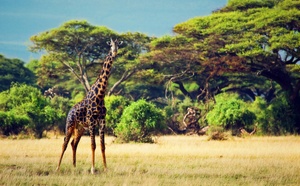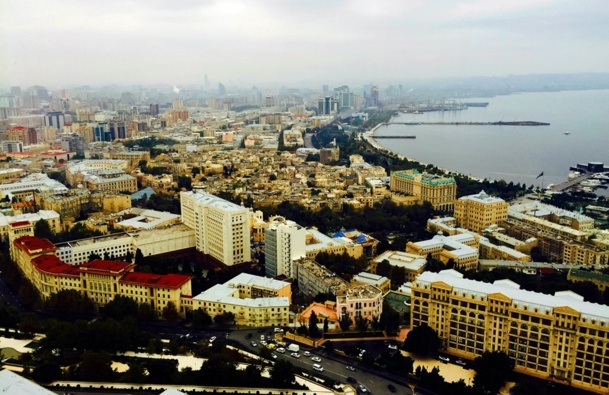
Bakou has all the qualities to become the Caucasus’ next “Dubai” /photo JDL
The airport road is a 2X4 lane road.
As we leave from the airport, we can see it, lit up like a Christmas tree with its roof resembling a yurt or the tent of a Pinder circus.
Right at the exit on the left, a totem proudly declares the city’s hosting of the 2015 European Games.
With a flame and chronological countdown clock appearing on a screen.
The volutes seem to look like those of the Olympic Games. Symbolic and evocative of the country’s ambitions…
A light rain sprays on the highly modern bus that takes the press group towards downtown hotels.
“Baku World Challenge” is written on the side of the bus, advertising the car race (*) taking place on November 1st and 2nd.
Around forty journalists from all over the world came to report on the country’s evolution, its event planning policies, and its progress in city planning.
And it is striking to notice that the government has been putting in lots of efforts. At least in Baku.
All along the road, one thing is sure: gone is the Bolchevik architecture of the occupation. In the capital, money and oil flow in abundance, and the architecture reflects this through spectacular and audacious forms, evoking a feeling of “nouveau rich.”
As we leave from the airport, we can see it, lit up like a Christmas tree with its roof resembling a yurt or the tent of a Pinder circus.
Right at the exit on the left, a totem proudly declares the city’s hosting of the 2015 European Games.
With a flame and chronological countdown clock appearing on a screen.
The volutes seem to look like those of the Olympic Games. Symbolic and evocative of the country’s ambitions…
A light rain sprays on the highly modern bus that takes the press group towards downtown hotels.
“Baku World Challenge” is written on the side of the bus, advertising the car race (*) taking place on November 1st and 2nd.
Around forty journalists from all over the world came to report on the country’s evolution, its event planning policies, and its progress in city planning.
And it is striking to notice that the government has been putting in lots of efforts. At least in Baku.
All along the road, one thing is sure: gone is the Bolchevik architecture of the occupation. In the capital, money and oil flow in abundance, and the architecture reflects this through spectacular and audacious forms, evoking a feeling of “nouveau rich.”
Numerous upcoming tourist infrastructures
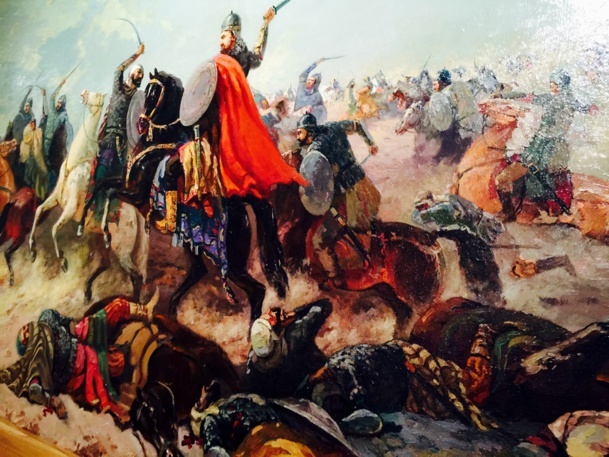
Alexander the Great, the Roman legions, the Shahs of Iran and the greatest generals have written on these lands glorious and tragic pages of the history of humanity / photo JDL.
Because at night, it’s all flashes on the giant screens that light and showcase supermodels or high-powered luxury cars.
The only humbling sight in this palace of exuberance: three men selling at an intersection red roses for lovers, the same ones found in Parisian restaurants and elsewhere.
We often compare the touristic ambition of Baku, Azerbaijan's capital with that of Dubai.
There are however, two important differences: in the emirates there is no oil and the cultural heritage of a few tribes, as important as it is, does not compare to that of this city’s deep, historically charged pass, as the bridge between Europe and Asia.
Alexander the Great, the Roman legions, the Shahs of Iran and the greatest generals have written on these lands glorious and tragic pages of the history of humanity.
A Humanity that takes roots in this land highly fertile in petroleum.
Coveted for its rich natural resources, the Azeri State, fervently independent, managed to free itself from the hands of its successive oppressors. Until it won its independence…in 1991!
Today, the country’s ambition to develop tourism is limited to Baku by necessity. Elsewhere, hotel infrastructures for individual tourism are lacking, even though the potential is there.
Some specialized travel agencies offer dedicated or combined tours.
The only humbling sight in this palace of exuberance: three men selling at an intersection red roses for lovers, the same ones found in Parisian restaurants and elsewhere.
We often compare the touristic ambition of Baku, Azerbaijan's capital with that of Dubai.
There are however, two important differences: in the emirates there is no oil and the cultural heritage of a few tribes, as important as it is, does not compare to that of this city’s deep, historically charged pass, as the bridge between Europe and Asia.
Alexander the Great, the Roman legions, the Shahs of Iran and the greatest generals have written on these lands glorious and tragic pages of the history of humanity.
A Humanity that takes roots in this land highly fertile in petroleum.
Coveted for its rich natural resources, the Azeri State, fervently independent, managed to free itself from the hands of its successive oppressors. Until it won its independence…in 1991!
Today, the country’s ambition to develop tourism is limited to Baku by necessity. Elsewhere, hotel infrastructures for individual tourism are lacking, even though the potential is there.
Some specialized travel agencies offer dedicated or combined tours.
Baku: future favorite of city trips?
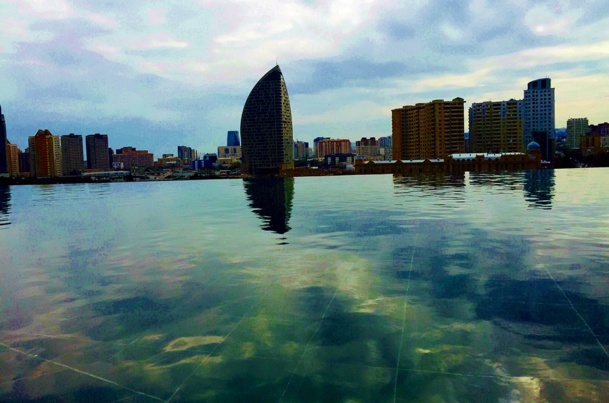
The authorities of the Ministry of Tourism believe so.
They’re announcing the upcoming establishment of a 2-3 star hotel complex and a network of guest houses along with the construction of large capacity ski resorts (10,000 people) in the north of the country within the next 6 to 7 years.
With its high peaks, rich and diverse wildlife (leopards were seen recently when they were believed to be completely eradicated from the Caucasus), and its flora, Azerbaijan could become one of the region’s star destination.
But from now, we have to recognize that it is still a work in progress. However, Baku is on the starting blocks to become, in medium term, a capital enjoyed by amateurs of city trips.
First of all, because the large international events expected in 2015 (2015 European Games, Grand Prize of Formula 1 in 2016), should give it the notoriety and credibility it has been running after for years.
Then, because two sights alone make the trip worth it: the astonishing Cultural Museum Heydar Aliyev Center, named after the current president’s father, 1st president after the independence, almost unknown (the museum) (see box) but that is up there with the Guggenheim of Bilbao, and the old town with its surrounding wall listed as a UNESCO world heritage site.
Let’s also mention, for good measure, the prehistoric site of Gobustan (also listed in UNESCO) and its museum, located 60 km from the capital.
An essential spot to directly look at one of the 6,000 petroglyphs that go back to the stone age (1.5 million years) and shine as true gems of prehistoric art.
Accommodations? No problem. There are many host infrastructures here in the capital with 80 identified hotels.
They’re announcing the upcoming establishment of a 2-3 star hotel complex and a network of guest houses along with the construction of large capacity ski resorts (10,000 people) in the north of the country within the next 6 to 7 years.
With its high peaks, rich and diverse wildlife (leopards were seen recently when they were believed to be completely eradicated from the Caucasus), and its flora, Azerbaijan could become one of the region’s star destination.
But from now, we have to recognize that it is still a work in progress. However, Baku is on the starting blocks to become, in medium term, a capital enjoyed by amateurs of city trips.
First of all, because the large international events expected in 2015 (2015 European Games, Grand Prize of Formula 1 in 2016), should give it the notoriety and credibility it has been running after for years.
Then, because two sights alone make the trip worth it: the astonishing Cultural Museum Heydar Aliyev Center, named after the current president’s father, 1st president after the independence, almost unknown (the museum) (see box) but that is up there with the Guggenheim of Bilbao, and the old town with its surrounding wall listed as a UNESCO world heritage site.
Let’s also mention, for good measure, the prehistoric site of Gobustan (also listed in UNESCO) and its museum, located 60 km from the capital.
An essential spot to directly look at one of the 6,000 petroglyphs that go back to the stone age (1.5 million years) and shine as true gems of prehistoric art.
Accommodations? No problem. There are many host infrastructures here in the capital with 80 identified hotels.
No less than eight 5 star establishments to be expected
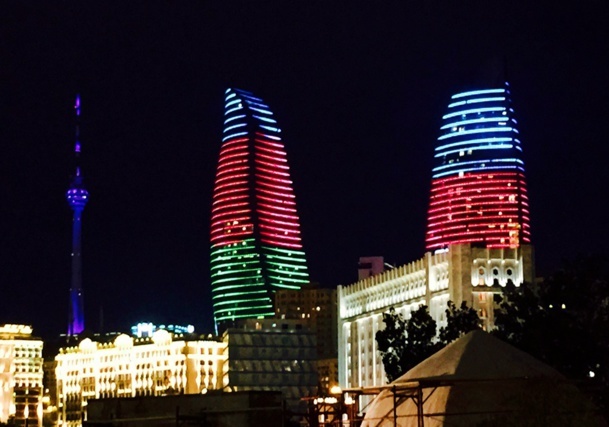
The Flame Towers, symbol of the triumphing Bakou /photo JDL
Eventually, no less than eight 5 star establishments (from the Marriott to Kempinski or Fairmont) are or will be built in Baku. While they may be in the same category, they’re not all worth the same…
Today, mostly focused on business tourism and MICE, they couldn't ask for more than also welcome an individual clientele, as highlights French businessman Pascal Leprou, recently nominated to head the sumptuous Fairmont Hotel, one of the emblematic branches of the Flame Towers that opened its doors less than a year ago.
Another element that adds to this hypothesis: adopting an electronic visa. A visa that should, eventually, be available on the destination’s website for an almost instantaneous download.
But we’re not there yet…
In short, we can say that the destination has all the criteria to become great urban tourism spot for a pleasant short stay.
As for possible (and desirable) improvements, access through Azerbaijan Airlines needs to be more efficient, the company just launched a Baku-New York line and is waiting for a first Boeing-787 Dreamliner in November, and a second one in December.
Let’s note that thanks to a partnership prompted by Turkish Airlines and Lufthansa, the Azeri capital is accessible through Istanbul and Frankfurt that serve as connections…since those can be complicated depending on the departure city.
Last but not least: Baku is not a low cost destination! In fact, the local currency (the Manat) is almost worth 1 euro and the cost of living in the Azeri capital is almost the same as in France.
(*) BlancPain Sprint Series. The race took place on a 4km long circuit that boards the Caspian ocean and circles around the Plaza of the National Flag. The Baku World Challenge was broadcasted in close to 175 countries.
(*) The Azeri GDP growth rate is one of the strongest in the world. It boomed between 2004 and 2009 with the average monthly wage tripling in 2009 ($371) to settle in 2012 at …$502!
Today, mostly focused on business tourism and MICE, they couldn't ask for more than also welcome an individual clientele, as highlights French businessman Pascal Leprou, recently nominated to head the sumptuous Fairmont Hotel, one of the emblematic branches of the Flame Towers that opened its doors less than a year ago.
Another element that adds to this hypothesis: adopting an electronic visa. A visa that should, eventually, be available on the destination’s website for an almost instantaneous download.
But we’re not there yet…
In short, we can say that the destination has all the criteria to become great urban tourism spot for a pleasant short stay.
As for possible (and desirable) improvements, access through Azerbaijan Airlines needs to be more efficient, the company just launched a Baku-New York line and is waiting for a first Boeing-787 Dreamliner in November, and a second one in December.
Let’s note that thanks to a partnership prompted by Turkish Airlines and Lufthansa, the Azeri capital is accessible through Istanbul and Frankfurt that serve as connections…since those can be complicated depending on the departure city.
Last but not least: Baku is not a low cost destination! In fact, the local currency (the Manat) is almost worth 1 euro and the cost of living in the Azeri capital is almost the same as in France.
(*) BlancPain Sprint Series. The race took place on a 4km long circuit that boards the Caspian ocean and circles around the Plaza of the National Flag. The Baku World Challenge was broadcasted in close to 175 countries.
(*) The Azeri GDP growth rate is one of the strongest in the world. It boomed between 2004 and 2009 with the average monthly wage tripling in 2009 ($371) to settle in 2012 at …$502!
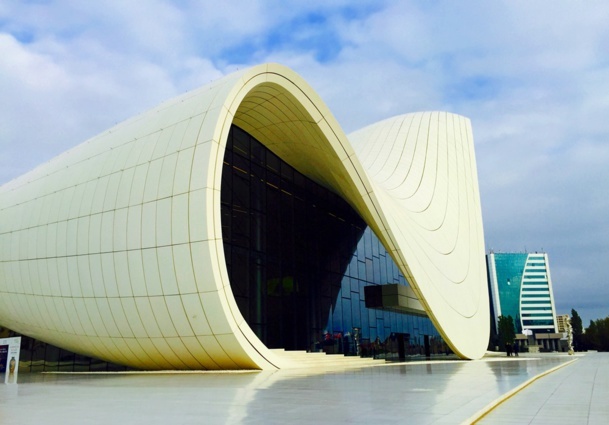
A fish, a wave, or a boat? That is up to the observer’s interpretation of this Zaha Hadid masterpiece… /photo JDL.
Heydar-Aliyev Cultural Center: the “Guggenheim” of the Caucasus?
The legend says that the famous architect Zaha Hadid would have thrown a piece of cloth in the air and the shapes it made as it was falling down have inspired the almost sensual curves of the impressive Heydar-Aliyev Cultural Center.
Whether true or not, this building alone, located on the Heydar-Aliyev Avenue and inaugurated on May 10th, 2012, makes a visit to Baku worth it.
With its convention center, museum, library, and 9 hectare wide park, this building is spectacular and is up there with some of the world’s top modern architectural creations.
While the outside of the center is inviting with its multifaceted silhouette, once inside the sight is as amazing. “The way the lighting was conceived changes how the building is seen by day and night”, explains an architecture magazine.
"During the day, the building’s volume reflects the light, shifts constantly in appearance as the day goes by and changes the perspective to visualize it. The use of a semi-reflective glass produces effects that titillate without revealing the fluid trajectory of the museum's interior…”
The museum features temporary exhibits. The work of Bernard Buffet, a French painter, is hosted there for the month of November 2014.
Whether true or not, this building alone, located on the Heydar-Aliyev Avenue and inaugurated on May 10th, 2012, makes a visit to Baku worth it.
With its convention center, museum, library, and 9 hectare wide park, this building is spectacular and is up there with some of the world’s top modern architectural creations.
While the outside of the center is inviting with its multifaceted silhouette, once inside the sight is as amazing. “The way the lighting was conceived changes how the building is seen by day and night”, explains an architecture magazine.
"During the day, the building’s volume reflects the light, shifts constantly in appearance as the day goes by and changes the perspective to visualize it. The use of a semi-reflective glass produces effects that titillate without revealing the fluid trajectory of the museum's interior…”
The museum features temporary exhibits. The work of Bernard Buffet, a French painter, is hosted there for the month of November 2014.
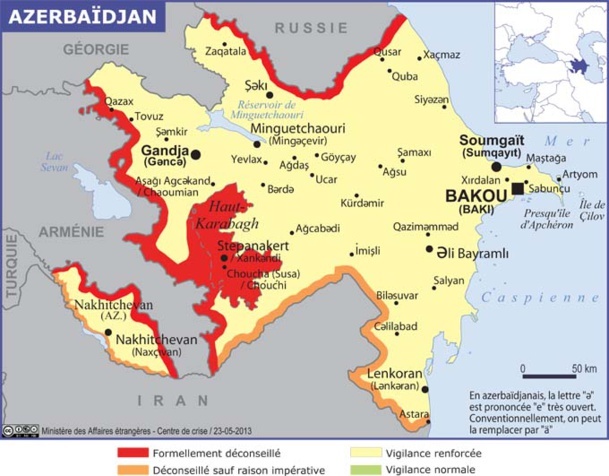








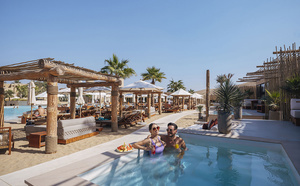







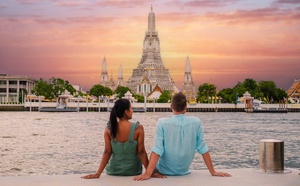
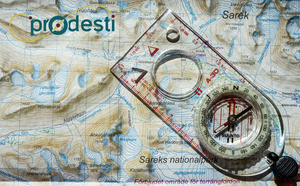










![Tourisme : où sont passés les Chinois ? [ABO] Tourisme : où sont passés les Chinois ? [ABO]](https://www.tourmag.com/photo/art/large_16_9/87929923-62307593.jpg?v=1744721842)
